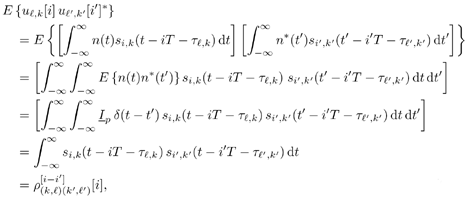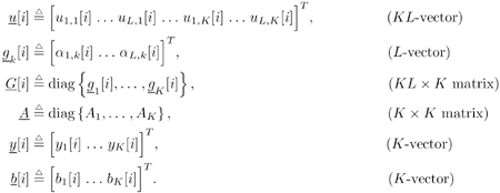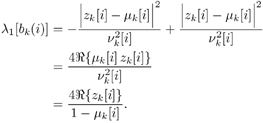6.5 Turbo Multiuser Detection in CDMA with Multipath Fading
| In this section we generalize the low-complexity SISO multiuser detector developed in Section 6.3.3 for synchronous CDMA systems to general asynchronous CDMA systems with multipath fading channels. The method discussed in this section was first developed in [257]. 6.5.1 Signal Model and Sufficient StatisticsWe consider a K - user asynchronous CDMA system employing a periodic spreading waveforms and signaling over multipath fading channels. The transmitted signal due to the k th user is given by Equation 6.131 where M is the number of data symbols per user per frame, T is the symbol interval, and A k , b k [ i ], and { s i,k (t) ; 0 The k th user's signal x k ( t ) propagates through a multipath channel with impulse response Equation 6.132 where L is the number of paths in the k th user's channel, and where a l,k (t) and t l,k are, respectively, the complex fading process and the delay of the l th path of the k th user's signal. It is assumed that the fading is slow: which is a reasonable assumption in many practical situations. At the receiver, the received signal due to the k th user is then given by Equation 6.133 where * denotes convolution. The received signal at the receiver is the superposition of the K users' signals plus the additive white Gaussian noise, given by Equation 6.134 where n(t) is a zero-mean complex white Gaussian noise process with power spectral density s 2. Denote Equation 6.135 Similar to the situations in earlier chapters, using the Cameron “Martin formula [377], the likelihood function of the received waveform r(t) in (6.134) conditioned on all the transmitted symbols b of all users can be written as Equation 6.136 where C is some positive scalar constant, and Equation 6.137 The first integral in (6.137) can be expressed as Equation 6.138 Since the second integral in (6.137) does not depend on the received signal r(t) , by (6.138) a sufficient statistic for detecting the multiuser symbols b is { y k [ i ]} i;k . From (6.138) it is seen that this sufficient statistic is obtained by passing the received signal r(t) through a bank of K maximal-ratio multipath combiners (i.e., RAKE receivers). Next, we derive an explicit expression for this sufficient statistic in terms of the multiuser channel parameters and transmitted symbols, which is instrumental to developing the SISO multiuser detector. Note that the derivations below are similar to those in Section 5.3.1 for space-time CDMA systems. Assume that the multipath spread of any user's channel is limited to at most D symbol intervals, where D is a positive integer. That is, Equation 6.139 Define the following correlation of the delayed signaling waveforms: Equation 6.140 Since t Equation 6.141 where { u k,l [ i ]} are zero-mean complex Gaussian random sequences with the following covariance: Equation 6.142 where I p denotes a p x p identity matrix and d ( t ) is the Dirac delta function. Define the following quantities : We can then write (6.141) in the following vector form: Equation 6.143 and from (6.142), the covariance matrix of the complex Gaussian vector sequence { u [ i ]} is Equation 6.144 Substituting (6.143) into (6.138), we obtain an expression for the sufficient statistic y [ i ], given by Equation 6.145 where v [ i ] is a sequence of zero-mean complex Gaussian vectors with covariance matrix Equation 6.146 Note that by definition (6.140), we have 6.5.2 SISO Multiuser Detector in Multipath Fading ChannelsIn what follows we assume that the multipath spread is within one symbol interval (i.e., D = 1). Define the following quantities: We can then write (6.145) in matrix form as Equation 6.147 where by (6.146), v (i) ~ N c ( , s 2 H [ i ]). Based on the a priori LLR of the code bits of all users, { l 2 ( b k [ i ])} i;k , provided by the MAP channel decoder, we first form soft estimates of the user code bits: Equation 6.148 Denote Equation 6.149 Equation 6.150 Equation 6.151 where e k denotes a 3 K -vector of all zeros, except for the ( K + k )th element, which is 1. At symbol time i , for each user, a soft interference cancellation is performed on the received discrete-time signal y [ i ] in (6.147), to obtain Equation 6.152 Equation 6.153 An instantaneous linear MMSE filter is then applied to y k [ i ] , to obtain Equation 6.154 where the filter Equation 6.155 where Equation 6.156 Equation 6.157 with The solution to (6.155) is given by Equation 6.158 As before, in order to form the LLR of the code bit b k [ i ], we approximate the instantaneous linear MMSE filter output z k [ i ] in (6.154) as being Gaussian [i.e., z k [ i ] ~ N c ( m k [ i ] b k [ i ], Equation 6.159 Equation 6.160 Therefore, the extrinsic information l 1 ( b k [ i ]) delivered by the instantaneous linear MMSE filter is given by Equation 6.161 The SINR at the instantaneous linear MMSE filter output is given by Equation 6.162 Recursive Algorithm for Computing Soft OutputSimilar to our earlier discussion, computation of the extrinsic information can be implemented efficiently . In particular, the major computation involved is the following K x K matrix inversion: Equation 6.163 Note that D k [ i ] can be written as Equation 6.164 where Equation 6.165 Substituting (6.164) into (6.163), we have Equation 6.166 where H (:,K+ k ) [ i ] denotes the ( K + k )th column of H [ i ]. Define Equation 6.167 Then by the matrix inversion lemma, (6.166) can be written as Equation 6.168 Equations (6.167) and (6.168) constitute a recursive procedure for computing Y k [ i ] in (6.163). Next, we summarize the SISO multiuser detection algorithm in multipath fading channels ( D = 1) as follows. Algorithm 6.4: [SISO multiuser detector ”multipath fading channel]
Finally, we examine the computational complexity of the SISO multiuser detector in multipath fading channels. By (6.167), it takes |
EAN: 2147483647
Pages: 91




 ,k
,k  [0,
[0,  D . Now substituting (6.134) into (6.138), we have
D . Now substituting (6.134) into (6.138), we have 












